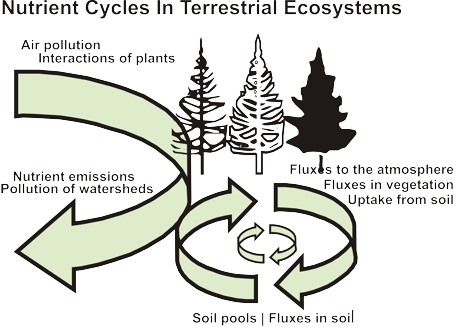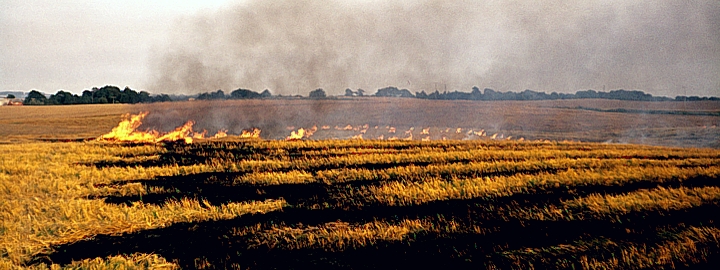 |
Terra Preta de Indio
Biochar Soil Management |
 |
Content: J. Lehmann
Host: Cornell University
|
 |
| © All original content belongs to Cornell University. This is a non-profit website for educational purposes that claims no ownership of copyright material. Other images and text belong to their respective owners. No copyright infringment intended. |
| |
| |
| |
|
| PL SCS 6720: Nutrient Cycling In Natural and Managed Ecosystems |
(3 credits)
Requirements: PLSCS 2600, 3720, NTRES 3210, BIOEE 4780 or equivalent, advanced knowledge of biological and chemical processes are beneficial |
| Short Description: Building on knowledge of physico-chemical and microbial nutrient transformations and exchange processes in soil, we will study the pathways of nutrients in ecosystems from the rhizosphere to the landscape level. We will include both natural and anthropogenic ecosystems, working with case studies from tropical and temperate environments. An important aspect will be the understanding of environmental impacts by agriculture, forestry and agroforestry and the development of sustainable landuse systems. We will explore various tracer methods for the study of nutrient cycling including stable and radio-isotopes as well as rare elements and biomarkers. You will expand your knowledge in discussion groups and through presentations and work in-depth on a project which involves both field and laboratory experimentation. The results of the project will be presented in a poster conference. |
This course is designed for all students who:
- who want to advance their knowledge on nutrient forms in soil in the context of the nutrient cycling in landuse systems
- who are interested in the biogeochemistry of nutrient elements of a broad array of ecosystems from agricultural fields, pasture, secondary to primary forests.
- who intend to further their knowledge about advanced methods in soil ecological work including isotopes.
- who are interested in field-based experimentation.
- who plan to do their thesis research or future work related to nutrient cycling.
|
| Course Description: The course targets graduate students, who intend to expand their
solid knowledge about processes, properties and dynamics of nutrients
and organic matter in soil to the biogeochemical cycling of nutrient
elements in natural and managed ecosystems. Nutrient transformations
and fluxes between soil pools and between the atmosphere, vegetation,
and ground water will be examined. Special attention will be paid
to the interaction of vegetation components in the soil ecosystem.
We will cover a diverse array of terrestrial ecosystems and discuss
the nutrient cycles in natural forest and grassland ecosystems,
the impact of natural and anthropogenic disturbance on nutrient
cycling and compare those to agricultural systems including pollution
with nutrients in watersheds. This course follows an experiential
learning approach, where students develop independent projects,
present a research proposal and conduct field research which concludes
with a presentation and paper in publishable format. The experimental
field work will be done in a landscape catena from natural forest
to plantation forest to agricultural fields, and includes measurements
of the main nutrient cycles such as litter fall, decomposition,
stemflow, throughfall, leaching in the soil, and nutrient uptake
by plants. In a lecture module, basic principles of nutrient cycles
in soil and the interfaces to the atmosphere, vegetation and groundwater
will be covered (seven 50-minute periods) as well as concepts of
ecosystem analysis discussed (eight 50-minute periods). In a seminar
module, students develop and present their research proposals, as
well as report the results from their experimentation (fifteen 50-minute periods). In the laboratory module, students set up experiments, collect and analyze samples. |
The course has several phases:
Lecture
Presentation of Research Proposals
Field Research (including a short oral presentation and poster)
Guided Discussion Groups |
| |
LECTURE
The goal of the lecture part of the course will be to introduce you to the basic information and principles of nutrient cycling in soil and in different terrestrial ecosystems, as well as highlight environmental aspects:
|
 |
| The nutrient cycle in soil ecosystems
Nutrient transformations between soil pools
Nutrient fluxes in soil
Root activity distribution and nutrient uptake from soil
Above ground nutrient flows in vegetation
Fluxes of nutrients to the atmosphere
Nutrients and the environment
Nutrient interactions of plants in natural and managed ecosystems
Nutrient emissions, pollution and climate change
Impact of air pollution on the nutrient cycle
Pollution of watersheds with P and N from agricultural fields |
FIELD EXPERIMENTATION (possible topics):
- Importance of throughfall, stemflow and litterfall for nutrient recycling in contrasting ecosystems
- Spatial distribution of nutrient return to soil in tree ecosystems
- Above- and belowground nutrient stocks in different ecosystems
- Dynamnics of nutrient release from litter in different ecosystems
- Nutrient release from litter and soil nutrient availability
- Root activity distribution of trees and crops
- Leaching of nutrients in forested and ploughed soil
- Biological N2 fixation and N transfer from legume to non-legume
|
GUIDED DISCUSSION (possible topics):
- Isotopic approaches to organic matter and nutrient dynamics in soil: P mineralization/N dynamics/S pollution
- Isotopic and mass approaches to biological nitrogen fixation
- Characterization of dissolved organic nutrient forms in ecosystems
- Measurements of root turnover and distribution
- Measurement of root activity and root nutrient uptake
- Field determinations of gaseous N losses
- Nutrient leaching in soil
- Modeling of nutrient cycling in ecosystems
|
| Grading: Point distribution:
Presentation of proposal (group score) 200
Presentation skills (individual score) 150
Written Proposal 250
Guided discussions 150
Poster Presentation 250
Total 1000
The grade will be based on the following scale:
1000 to 900 points (100 to 90 %) = A
899 to 800 points (89.9 to 80 %) = B
799 to 700 points (79.9 to 70 %) = C
699 to 600 points (69.9 to 60 %) = D
below 600 points (below 60 %) = F |
|



